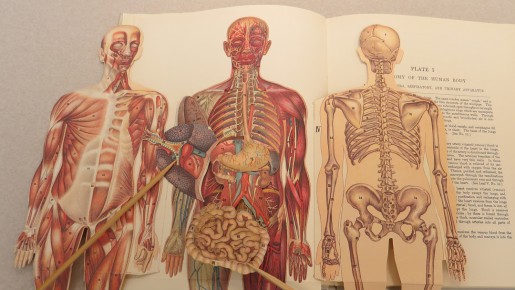A new exhibit explores human anatomy illustrations which feature ingenious paper flaps and pop-ups that essentially transform 2-D diagrams into 3-D interactive objects.
As early as 1538, woodcut illustrators were producing posters to depict anatomy in three-dimensional form through the use of hinged, paper flap overlays. The body’s interior was revealed by lifting subsequent flaps, for example, from the torso inward through muscles, organs, and ending at the spine. The posters, known as anatomical fugitive sheets, were typically produced in pairs to illustrate both male and female figures.

Subsequently, the paper flap method employed in posters was adopted for books. Andreas Vesalius’ De humani corporis fabrica librorum epitome* was one of the first books to integrate the technique in 1543. Remarkably, Epitome included illustrations of the body and a spare page containing anatomical parts that could be cut out, pasted, and configured into a functional paper flap anatomy!
From the time of the cut-and-paste Vesalius until 1800, just 9 book titles have been identified that contain flap anatomies. Such rarity is understandable, given that flaps could be created only through arduous printing techniques, such as woodcut or copperplate engraving. As printing technology evolved, flaps became easier to produce, and appeared in vibrant, dramatic colors. The publication of lift-the-flap anatomy books reached its apex in the 19th century, and waned in the early 20th century. Children’s books, primarily those containing pop-ups, began to dominate the interactive-book market. Pop-ups are engineered to transform a flat surface into a 3-D object as a page is opened. Pop-up anatomy books for children are still published—an enduring legacy of the lift-the-flap anatomy posters first produced 475+ years ago.
The exhibit features anatomical fugitive sheets (facsimiles), colorful lift-the-flap books, and pop-up anatomies. Displays are located in the lobbies both inside and outside the library entrance, through April 30.
Want to learn more? Here’s a list of resources.
~Rebecca Abromitis
*Epitome is the companion piece to Vesalius’ masterpiece of anatomical science and art: De humani corporis fabrica [On the fabric of the human body], 1543.